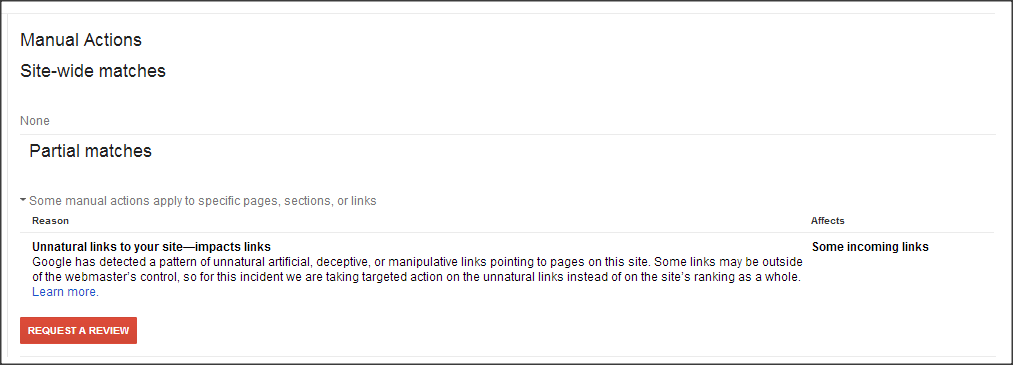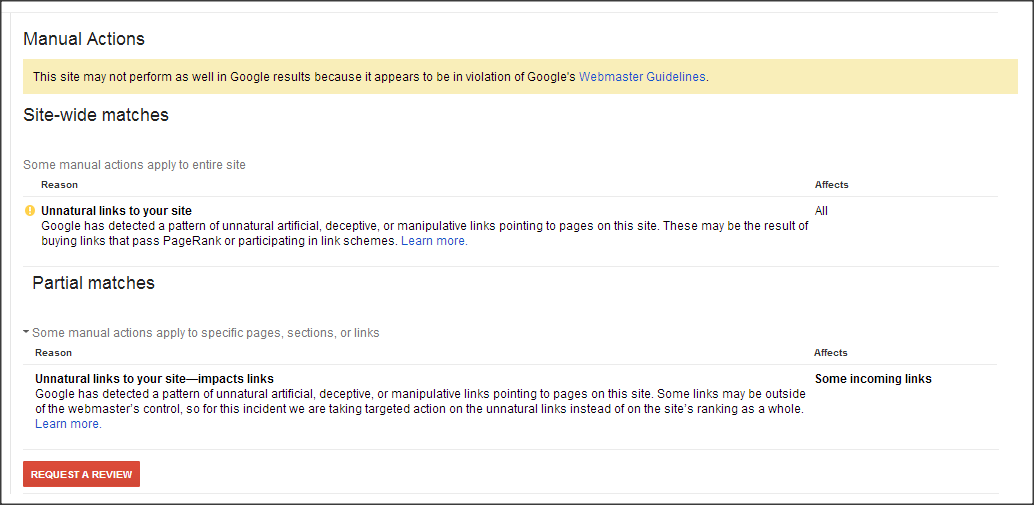What is the difference between a Google penalty on an ecommerce site, compared to another type of website?
In terms of the action taken against your website then there is no difference, but due to the type of penalty involved, it can have very serious implications for your business. It’s one thing to have a relatively mild Google Penguin algorithmic devaluation of your rankings for a few select keyword phrases, but it’s quite another to be de-indexed for your brand name!
Google has been sending out very harsh punishments for breaking their quality guidelines, and this trend is likely to continue into 2014 and beyond. So, more people need to be aware of the potential time bomb they could be sitting on when it comes to their ecommerce website.
Introduction
What are the types of Google penalties?
Now, unfortunately there are many more issues than just Penguin, Panda and manual spam actions. Strictly speaking, neither Panda or Penguin are actually penalties, but algorithmic updates. I’m not going to talk about Panda, as that isn’t really the focus of this blog post, but I’d encourage my #ecomchat friends to read more.
How to see if you have a Google manual action against your ecommerce site?
Eventually Google decided it might be a good idea to display notifications of manual actions in a Google Webmaster Tools section, rather than just sending a message in Webmaster Tools, or not to bother telling a webmaster at all!!! Therefore, since this was introduced in August 2013 it’s been a lot easier to see if you have a manual action.
How do you identify manual action because of your backlinks?
Here are examples of both a partial and a site-wide match notification from manipulated links uncovered by Penguin which when reviewed were given a manual action.


If you see either of these in Google Webmaster Tools then you have already received a manual action!
The Google Penguin Algorithm
Note that we’ve only been talking about a manual action, and not the Penguin algorithm. Penguin is an automated process which is part of the overall search algorithm, and this periodically targets sites which are manipulating links (a key part of the Google algorithm).
You’re not safe yet!
Now the chances are that if you’re working on an old ecommerce website, then someone over the years has dabbled in a little back hat SEO!
Let’s be honest, this is how many online brands made so much money = cheap traffic. All you have to do is read the horror stories of brands being ousted for their manipulative practices by the online SEO community; a topic which although very popular currently, is becoming increasingly mundane.
Potential future risk
As the Google Penguin algorithm gets increasingly more sophisticated (probably because of all that crow-sourced data from the Disavow file), then there is an ever-growing risk that your ecommerce site domain history will catch up to you.
If you think that your ecommerce website has been ‘SEO’d’ in the past, by an ‘SEO Expert’ none the less, then I would strongly recommend you doing a bit of research. If this isn’t your specialism, then I would recommend hiring someone with previous proven experience of Google penalties to do a forensic link analysis of the domain, and determine the future risk. I would always go on a recommendation – speak to companies/people who’ve successfully removed a penalty before.
Backlink anchor text – a tell tail sign
Long before Penguin 1.o I warned against the dangers of an SEO company destroying your link profile. I’m not going to go into how to identify bad backlinks, as that would take forever, but I’m going to touch on link anchor text.
Warning SEO history lesson
Now for many years Google had a very easily manipulated/flawed algorithm. It looked at the anchor text of a backlink, and used this to add extra ‘power’ to the target of the link (ie. helped the target to go up the rankings). This wasn’t the only metric, but black hat SEO’s soon cottoned on to the fact that link spam worked. If you wanted to rank for blue widgets, all you had to do was point a load of links containing the exact anchor text blue widgets to the site/page which you wanted to rank for the term.
A domain could still get a manual action for manipulative links before Penguin, but this was much rarer and because Google didn’t even bother to tell a webmaster most people would never know, unless you knew how to read the tell tale signs.
So if you believe that the domain might be at risk, I would recommend having a look at your anchor text percentages first. If you have a high percentage of commercial anchor text then there is a good chance this was manipulative and you should certainly do a full forensic link audit.
Should you remove bad links from your link profile, even if you haven’t got an algorithmic Penguin issue?
I can’t stress enough how much ecommerce website stakeholders should take action, rather than burying their heads in the sand, hoping the problem will go away.
I’m not going to name names, but in the last year I’ve seen 100s of high street brand names in the UK have issues with either algorithmic Penguin or manual spam actions, solely because of their links. If you’ve got a bad enough link profile to hit the trigger for that particular Penguin update then in a day or so you’ll notice!
What’s the next step now I think I might have a problem?
Getting buy in
There is one easy way to see if you, as an ecommerce site, should be taking the threat of a Google Penguin or manual action seriously:
How much money do you make from Google organic? Can you afford to not do a full risk analysis?
Analytics
Bloody hell, did an SEO say your next step is to look at the data?
…That’s right; you heard it here first!
Get some numbers before you go any further:
- Create a filter for Google organic as the source/medium
- Use a couple of years’ worth of data
- Look at which landing pages are getting you traffic/revenue – has this changed? Unfortunately (not provided) keyword data means it’s hard to drill down to a specific keyword (the most typical type of manual action)
Your analytics data, ecommerce sales data, and backlink profile data should give you the answer on whether you need to take action.
What should I do next?
Should I ignore, disavow links, remove links, or request reconsideration?
If you get to this point then you should certainly get some help. I’d highly recommend some impartial PAYG consultancy from someone who specialises in Google algorithmic issues and link penalty removal.
Here are a few boiler plate scenarios:
Q. The domain has had SEO work done in the past, and I noticed a fall in the rankings.
A. Look in your Google Webmaster tools first, to see if you have a manual action. If you don’t, pin point the week when you noticed the fall in traffic and compare it to a history of Google updates.
Q. We had a manual notification about our links in Google Webmaster Tools, but haven’t really noticed any impact.
A. Although you might have a manual action, you might not have noticed any impact on revenue or traffic. Just because you haven’t yet, it doesn’t mean you won’t in the future. The reason for this is that although you might not rank as well for [blue widgets] anymore, you might still rank for all the stemming phrases, synonyms and long tail traffic around the term [blue widgets]. The truth is that the site could be still getting some positive benefit from these manipulative links, even though we would categorise them as ‘bad links’. I would suggest in general that these low quality ‘bad links’ are probably doing the site more harm than good. In addition, there is also the risk of being upgraded from a partial match manual action to a site wide manual action – so beware!
Q. We were hit by Penguin
A. If you didn’t get a manual notification then you’re going to be held back by your bad backlinks until you do something about them. I would recommend conducting a full manual forensic link analysis followed by a link removal program and disavow file upload.
Q. I’m worried we have an issue, or could have one in the future
A. Don’t worry – you’re in the same boat as 10,000s (if not 100,000s) of other ecommerce websites.

